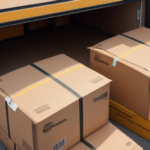What Happens to Items Returned to Amazon?
Amazon is one of the most popular online marketplaces today, with millions of customers purchasing a wide range of products from the site every day. While Amazon strives to ensure customers are satisfied with their purchases, there are instances where customers may want to return items. Whether it's a product that doesn't meet their expectations or one that's damaged or faulty, returns are a part of the shopping experience on Amazon. But what actually happens to these returned items?
The Journey of an Amazon Return
Initiating a Return
When a customer decides to return an item, they can initiate the process through their Amazon account. Depending on the reason for the return, customers may have different options, such as requesting a replacement, a refund, or exchanging the product. Amazon provides a user-friendly interface that guides customers through the return process, ensuring it is as seamless as possible.
Shipping the Returned Item
Once the return is initiated, Amazon generates a prepaid shipping label for the customer. Customers can choose to drop off the package at designated locations or schedule a pickup. According to Amazon's Return Policy, many returns are free of charge, especially for items that are defective or not as described.
Inspection and Processing
After the returned item arrives at Amazon's facility, it undergoes a thorough inspection to determine its condition. Using advanced data analytics and automated systems, Amazon assesses whether the item is in a resellable state, needs refurbishment, or should be recycled. This process ensures that customers receive quality products and helps Amazon manage inventory effectively.
Inside Amazon's Returns Department
Inspection and Grading
Amazon employs a team of returns processors who meticulously inspect each returned item. Items are graded based on their condition:
- New: The item is unopened and unused.
- Like New: The item shows minimal signs of use.
- Used: The item has visible wear and may require refurbishment.
- Damaged: The item is broken or non-functional.
Refurbishment and Recycling
Items that can be refurbished are sent to certified facilities where they are repaired and tested to meet Amazon's quality standards. Refurbished products are then resold as "Renewed" items, providing customers with reliable products at a lower price point. Items that cannot be refurbished are either recycled or responsibly disposed of, minimizing environmental impact.
Sustainability Initiatives
Amazon is committed to sustainability and reducing waste. The company has implemented initiatives such as Frustration-Free Packaging, which minimizes packaging materials, and partners with recycling organizations to ensure returned items are processed responsibly. These efforts contribute to Amazon's goal of achieving net-zero carbon by 2040.
The Lifecycle of a Returned Item
Resale as New or Used
Depending on their condition, returned items are either returned to inventory for resale as new or used, or sent to liquidation centers. For example, a returned laptop in excellent condition may be sold as "Renewed," while a returned book may be sold at a discount as "Used."
Liquidation and Donation
Items that cannot be resold through Amazon are often liquidated in bulk to third-party buyers. Additionally, Amazon partners with charitable organizations to donate usable items, such as clothing and toys, to those in need, further extending the lifecycle of returned products.
Unclaimed Returns
If a customer does not claim their returned item within a specified timeframe, Amazon may choose to liquidate the item or donate it. This practice helps Amazon manage inventory efficiently and reduces the environmental impact of unclaimed goods.
Impact of Returns on Amazon's Business Model
Financial Implications
Returns are a natural part of e-commerce but can impact Amazon's profitability due to shipping costs, restocking fees, and potential loss of inventory value. According to industry reports, the average return rate for online retailers is between 20-30%, which Amazon manages through efficient processing and data-driven strategies.
Data Analytics and Optimization
Amazon leverages advanced data analytics to identify patterns in returns, such as common reasons for returns or high return rates for specific products. This information allows Amazon to optimize product descriptions, improve quality control, and enhance customer satisfaction, ultimately reducing future return rates.
Sustainability and Waste Reduction
By refurbishing and recycling returned items, Amazon reduces waste and promotes a circular economy. These efforts not only align with global sustainability goals but also enhance Amazon's reputation as an environmentally responsible company.
The Role of Customer Feedback in Returns
Insights from Return Reasons
When customers return items, they are often asked to provide a reason. This feedback is invaluable for Amazon, offering insights into product quality, customer expectations, and market trends. By analyzing return reasons, Amazon can make informed decisions about inventory, partnerships, and product offerings.
Improving Product Offerings
Customer feedback from returns helps Amazon and third-party sellers improve their products. For instance, if multiple customers return a product due to sizing issues, sellers can adjust their sizing charts or offer more detailed product descriptions to reduce future returns.
Legal and Environmental Considerations
Compliance with Regulations
Amazon must adhere to various legal regulations related to returns, such as consumer protection laws and environmental guidelines for waste disposal. Compliance ensures that Amazon maintains trust with customers and avoids legal repercussions.
Environmental Impact
Returns can contribute to increased carbon emissions due to additional shipping and processing. However, Amazon's sustainability initiatives, such as using renewable energy in facilities and promoting recycling, help mitigate these environmental impacts. According to Amazon's 2023 sustainability report, the company has reduced its carbon footprint by 15% through efficient returns processing and recycling programs.
Behind the Scenes: Amazon's Returns Processing Team
Roles and Responsibilities
Amazon's returns processors play a critical role in ensuring returned items are handled efficiently and sustainably. Their responsibilities include inspecting items, grading their condition, determining the appropriate next steps, and managing inventory updates.
Skills and Training
Employees in the returns department undergo extensive training to recognize product conditions, use assessment tools, and adhere to Amazon's sustainability protocols. Their expertise ensures that returned items are processed accurately, minimizing errors and enhancing overall efficiency.
Conclusion
Amazon's return policy is a comprehensive system designed to balance customer satisfaction with operational efficiency and sustainability. By utilizing advanced data analytics, partnering with certified refurbishment facilities, and implementing eco-friendly initiatives, Amazon effectively manages returns to minimize their impact on the business and the environment. Continuous improvement based on customer feedback ensures that Amazon remains a leader in providing a reliable and convenient shopping experience.




















